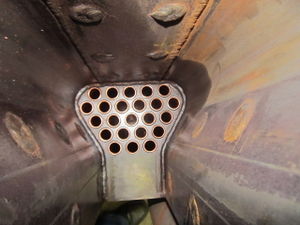Boiler Material
Jump to navigation
Jump to search
Copper
- How much stronger is Type K over type L copper tubing? Only 0.009" difference in the wall.
- Let's assume for the moment you are looking for a boiler barrel (The barrel is the long'ish, tubular, front part of the boiler). If you run it through the applicable formlae for boiler barrels you will find that Type M is actually sufficiently strong for 100psi steam. But because there are always other forces acting on the boiler, both during and after construction, as Bill has just mentioned, I don't use Type M. All three types meet the basic strength requirements, but the extra rigidity and weight of Types K and L allow me to handle the material a little bit more like a solid and machine and work it with less concern for deformation. My personal preference is Type L for barrels and Type K for flues. I can usually get Type L locally but the Type K for flues almost always has to be ordered.
Steel
- Pipe and HRS plate are NOT the material to build a boiler, unless the pipe is something like oil well casing which has the same specification / inspection requirements as boiler tubing (I worked for an oil company for 10 years and know this from experience). You need to get certified material that is OK for Pressure Vessel application. A36 is a grade that comes to mind -> here are others, but my head is in European / DIN grades and for the life of me cannot remember the ANSI equivalents at this time.
- I prefer to use rod stays (as opposed to girders). It is easier to calculate the stresses, they don't put a bending stress on the side stays, and they allow better circulation.
- Seamless pipe, SA106B, would be my first choice for the shell. Flat plates should be Pressure Vessel Quality, SA516-Gr70 is the most common. Couplings and half couplings should be 3000# forged steel, ASTM A105. Stays and mudrings can be made from SA36.
- 10" pipe is 10 3/4" OD. In a boiler this size (10-inch diameter by 41-inch length) I usually use 5/16" plate.
- I use only PVQ plate. Sa285 GrC is getting harder to find these days. SA516 Gr70 is much easier to get. Boiler plate used be sold as firebox quality or flange quality. Those terms fell into disuse in the early 70's, about the time I started building boilers. The current term used is PVQ, for Pressure Vessel Quality.
What not to use
- It's not a good idea to use brass in a boiler, as it can suffer de-zincification (and failure). I expect the pieces you have are made of bronze, not brass. Bronze does not suffer the same fate.
